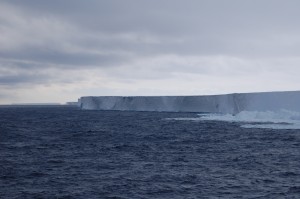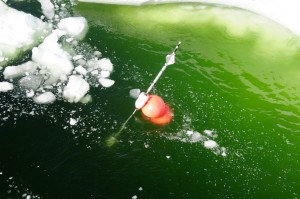29 December 2015
In Antarctica, melting ice drives unusual phytoplankton growth
Posted by Lauren Lipuma
by Alison F. Takemura
In most of the Southern Ocean, phytoplankton – the base of the marine food web – grow poorly because they’re starved for iron. But in the Amundsen Sea on the west coast of Antarctica, phytoplankton abound in summer. A new study now shows the reason behind the sea’s startling productivity: meltwater from an abutting ice shelf flows into the sea, buoys iron to the surface and jumpstarts phytoplankton growth.
Previous research has shown iron must be getting into the upper sunlit waters of the Amundsen Sea, but until now, scientists have not been able to figure out where the iron comes from, said Patricia L. Yager, an oceanographer at the University of Georgia in Athens and coauthor of the study. Yager and her colleagues wondered if the iron might be trickling in from the Dotson Ice Shelf, a part of the West Antarctic Ice Sheet that extends out over the Amundsen Sea.
To test that hypothesis, Yager and her colleagues sampled water from the surface to about 1 kilometer (0.6 miles) deep along a 50-kilometer (30-mile) transect following the ice shelf’s edge, as well as about 300 kilometers (200 miles) from the shelf into the sea. In thousands of water samples taken during the southern hemisphere’s summer — December 2010 to January 2011— Yager’s team measured iron and chemical markers of phytoplankton activity: chlorophyll, oxygen, nitrate, and nitrite. With these values, the team built a snapshot of iron abundance and phytoplankton growth in the sea. They also tracked the movement of the meltwater underneath the ice shelf. Yager presented the results of the study at the 2015 American Geophysical Union Fall Meeting in San Francisco.

Meltwater from the Dotson Ice Shelf, shown here, carries up iron-rich deep water in the Amundsen Sea, new research shows.
Credit: Patricia L. Yager.
The team found that a “flow of seawater equal to the Amazon River,” rich in both iron and glacial meltwater, gushes from underneath the ice shelf into the sea, said Robert Sherrell, a marine biogeochemist at Rutgers University and coauthor of the study.
But the meltwater itself doesn’t bring iron along, Yager said. As the fresh melt mixes with the denser salt water below, it forms a buoyant plume that moves iron-rich deep water to the surface. The push drives up the concentration of dissolved iron in the upper 50 meters (160 feet) — where phytoplankton can thrive — to about 0.4 nanomoles per kilogram of water. The melting ice shelf provides a continuous supply of iron that fuels the sea’s verdant productivity, she said.
“As soon as the iron gets to the surface, [the phytoplankton] suck it up right away,” Yager said.
As phytoplankton grow, they draw carbon dioxide from the atmosphere and sequester it in the ocean. According to Yager, the high phytoplankton activity in the Amundsen is akin to planting a forest: the Amundsen is only a quarter of a percent the size of the total Southern Ocean, yet accounts for two to three percent of the carbon dioxide it absorbs, she said.
Climate change could continue to increase meltwater and iron availability, encouraging phytoplankton growth in the short term, Yager said. But if unchecked, she continued, climate change could bring it to a halt by getting rid of an equally important factor: sea ice. The springtime melting of seasonal sea ice helps the phytoplankton get enough light by making a stable layer of water near the sunlit surface. If the ice disappears, the delicate layers of the sea will blend together, and the wind will mix phytoplankton down to where they can no longer bloom, she said.
If that happens, “the extra iron won’t help,” she said.
Yager’s research provides a tangible answer to how ice sheet melting influences biological systems, said Shanlin Wang, a climate modeler at Los Alamos National Laboratory in New Mexico who was not involved in the study. Wang studies how the melting of sea and land ice affects nutrients available to marine microorganisms and hopes to incorporate Yager’s data into her computational models.
“We need this kind of work in modeling, to make sure we get the processes correct,” Wang said.
– Alison F. Takemura is a science communication graduate student at UC Santa Cruz. You can follow her on twitter at @AlisonTakemura.




 GeoSpace is a blog on Earth and space science, managed by AGU’s Public Information staff. The blog features posts by AGU writers and guest contributors on all sorts of relevant science topics, but with a focus on new research and geo and space sciences-related stories that are currently in the news.
GeoSpace is a blog on Earth and space science, managed by AGU’s Public Information staff. The blog features posts by AGU writers and guest contributors on all sorts of relevant science topics, but with a focus on new research and geo and space sciences-related stories that are currently in the news.